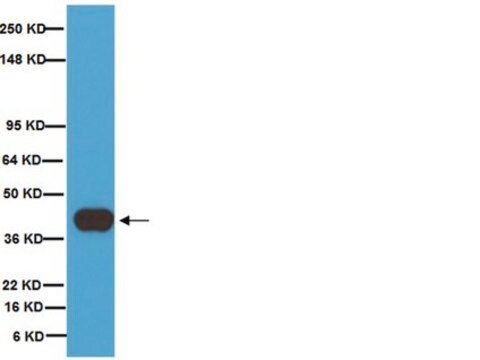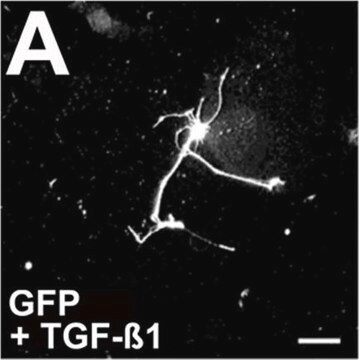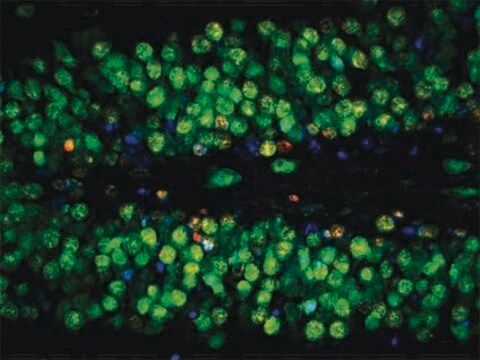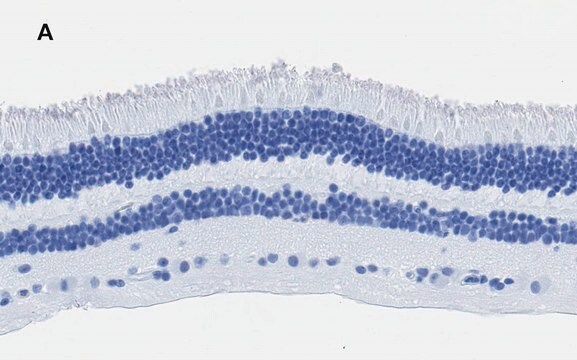CBL212
Anti-Neurofilament 200 kDa Antibody, clone RT97
clone RT97, Chemicon®, from mouse
Sign Into View Organizational & Contract Pricing
All Photos(1)
About This Item
UNSPSC Code:
12352203
eCl@ss:
32160702
NACRES:
NA.41
clone:
RT97, monoclonal
application:
IHC (p)
species reactivity:
rat, human, pig, avian, chicken, reptile
technique(s):
immunohistochemistry (formalin-fixed, paraffin-embedded sections): suitable
citations:
12
Recommended Products
biological source
mouse
Quality Level
antibody form
purified antibody
clone
RT97, monoclonal
species reactivity
rat, human, pig, avian, chicken, reptile
species reactivity (predicted by homology)
mammals
manufacturer/tradename
Chemicon®
technique(s)
immunohistochemistry (formalin-fixed, paraffin-embedded sections): suitable
isotype
IgG1
NCBI accession no.
UniProt accession no.
shipped in
wet ice
Specificity
The clone RT97 recognizes the 200 kDa neurofilament polypeptide in a number of mammalian and avian species. Tumours specifically recognized include phaeochromocytoma, paraganglioma, ganglioneuroblastoma and other tumours of neuronal origin.
KNOWN SPECIES CROSS REACTIVITY: Recognizes rat, chicken, pig and reptile
KNOWN SPECIES CROSS REACTIVITY: Recognizes rat, chicken, pig and reptile
Application
Anti-Neurofilament 200 kDa Antibody, clone RT97 detects level of Neurofilament 200 kDa & has been published & validated for use in IH, IH(P).
Research Category
Neuroscience
Neuroscience
Research Sub Category
Neurofilament & Neuron Metabolism
Neuronal & Glial Markers
Neurofilament & Neuron Metabolism
Neuronal & Glial Markers
Staining of both frozen and paraffin wax embedded tissue sections
Strong staining of neuronal processes in a variety of tissues
Optimal working dilutions must be determined by the end user.
Strong staining of neuronal processes in a variety of tissues
Optimal working dilutions must be determined by the end user.
Physical form
Format: Purified
The monoclonal is presented in phosphate buffered saline containing 10mM sodium azide and 1mg/ml bovine serum albumin. We recommend that each laboratory determine an optimum working titre for use in its particular application.
Storage and Stability
Stable for 1 year at 2-8°C from date of receipt
Other Notes
Concentration: Please refer to the Certificate of Analysis for the lot-specific concentration.
Legal Information
CHEMICON is a registered trademark of Merck KGaA, Darmstadt, Germany
Disclaimer
Unless otherwise stated in our catalog or other company documentation accompanying the product(s), our products are intended for research use only and are not to be used for any other purpose, which includes but is not limited to, unauthorized commercial uses, in vitro diagnostic uses, ex vivo or in vivo therapeutic uses or any type of consumption or application to humans or animals.
recommended
Product No.
Description
Pricing
Storage Class Code
12 - Non Combustible Liquids
WGK
WGK 2
Flash Point(F)
Not applicable
Flash Point(C)
Not applicable
Certificates of Analysis (COA)
Search for Certificates of Analysis (COA) by entering the products Lot/Batch Number. Lot and Batch Numbers can be found on a product’s label following the words ‘Lot’ or ‘Batch’.
Already Own This Product?
Find documentation for the products that you have recently purchased in the Document Library.
2-(Cyclohexylamino)-1-(4-cyclopentylpiperazin-1-yl)-2-methylpropan-1-one, a novel compound with neuroprotective and neurotrophic effects in vitro.
H Elbr?nd-Bek,A Wellejus,N M Kelly,M S Weidner,S H J?rgensen
Neurochemistry International null
Tissue engineering a complete vaginal replacement from a small biopsy of autologous tissue.
Roger E De Filippo,Roger E De Philippo,Colin E Bishop,Luiz Freitas Filho,James J Yoo,Anthony Atala
Transplantation null
Signals for the initiation and termination of synthesis of the viral strand of bacteriophage f1.
Dotto, G P, et al.
Cold Spring Harbor Symposia on Quantitative Biology, 47 Pt 2, 717-722 (1983)
Hisashi Hashimoto et al.
Neuro-degenerative diseases, 17(4-5), 181-198 (2017-05-11)
A novel ataxic mouse line was established from the offspring of a male mouse administered cyclophosphamide in a juvenile period. We have attempted to examine the phenotype and histopathological changes of affected mice. Furthermore, linkage analysis and sequencing of the
Iris Adam et al.
Current biology : CB, 31(14), 3115-3124 (2021-06-06)
The motor control resolution of any animal behavior is limited to the minimal force step available when activating muscles, which is set by the number and size distribution of motor units (MUs) and muscle-specific force. Birdsong is an excellent model
Our team of scientists has experience in all areas of research including Life Science, Material Science, Chemical Synthesis, Chromatography, Analytical and many others.
Contact Technical Service






